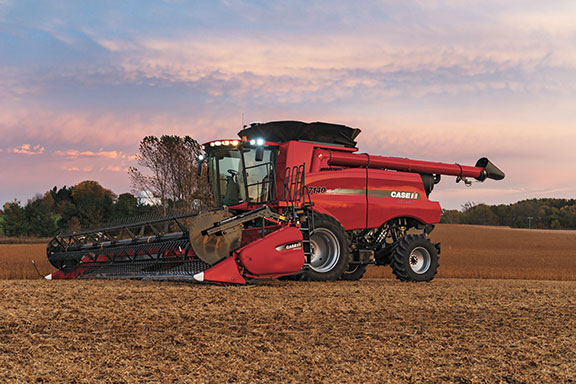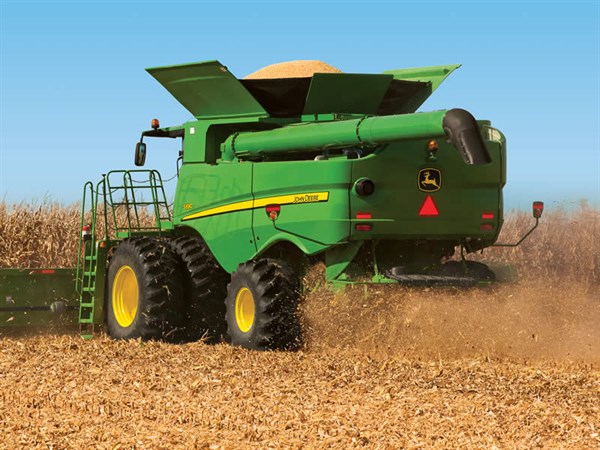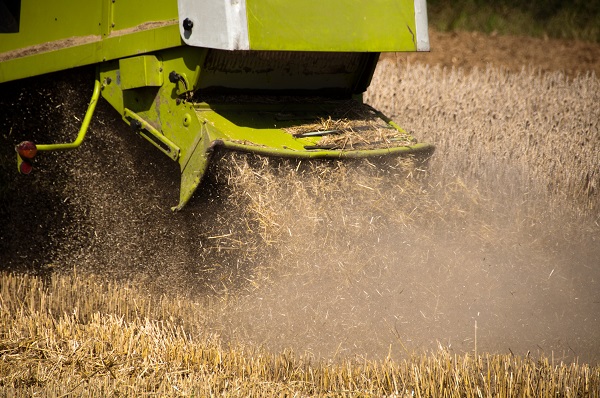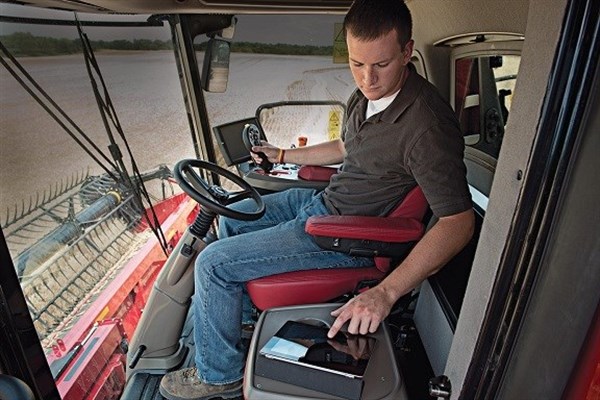Combine harvester shopping can be a daunting task, so here are some tips on purchasing your harvester.
 |
|
The Case IH 7140 combine harvester
|
The combine harvester is probably one of the most important inventions in the agricultural industry as it helps farmers save serious time and labour costs at harvest.
However, due to their sheer size and complex technology, combines do not come cheap. The price, depending on the combine class, can easily exceed half a million dollars. Hence it is certainly not an investment farmers take lightly.
Therefore, if you are in the market to purchase one for your operations, it is crucial to know what to look for and points to consider before committing to a potentially life changing decision.
First of all, what are you expecting out of your harvester?
A good harvesting operation should ensure:
- A timely harvest
- Maximum grain in the bin
- An optimal throughput
- Harvested products are of the best quality
- Harvest is undertaken with least amount of losses
- An economical and reliable operation
Modern grain harvesting machines operating in Australia are all rotary or hybrid-rotary machines. Combines with walker-type separators have all but been superseded and hence will not be considered in this piece.
Find new and used combine harvesters for sale
1. Know your classes
John Deere markets their S-series combines in Australia; the S660 is a Class Six combine, while the S690 a Class Nine model. These are single rotor rotary machines that use centrifugal separation. Image: John Deere
In the ‘good old days’ of walker-type machines with tangential-feed cylinders, combine capacity was practically dependent on and measured or rated by cylinder and walker width.
That all changed when axial flow ‘rotary’ designs came on the scene after 1977 and these have eclipsed cylinder machines.
Nowadays combine capacity is largely dictated by engine power and cleaning shoe area.
So what are combine classes and what dictates which classes a combine should fall under?
As a rule of thumb, the higher the power of the harvester, the higher the class. For example, Case IH’s Axial Flow 6130 which offers 320hp falls under Class Six, while Claas’ Lexion 750 with 442hp sits under Class Nine.
However, the guidelines in combine classification often change, as explained in this article by Agweb. More often than not, companies create their own classes when they produce a machine outside a specified class.
Hence combine class ratings may be decided more by marketing intelligence than by engineering features.
Combines offered today in Australia ranges from Class Six to Class Ten.
2. Choose your brand wisely
Given the time pressures at harvest, it is critical that the machine be reliable. This means choosing a brand with a reputable product backup and dealer performance.
Think well-known, tried and tested brands such as John Deere, New Holland and Case IH which have a wide network of dealers meaning backup and parts won’t be a problem.
Make sure your dealership is not too far away should you run into any problems and that they have a good backup of parts.
Some brands might even have mobile service trucks in selected regions come harvest time for 24 hour services should problems occur. Just be sure to ask the question when it’s time to buy.
3. Grain header > combine capacity
A simple but very important rule to remember is: a combine’s capacity should never be more than the gathering head can digest.
As harvesting starts from the front, gathering systems are critically important in the overall scheme of grain harvesting and should be taken into consideration when purchasing your harvester.
Some might think the head is not a processor but consider this example: In some conditions a stripperhead can thresh out more than half the grain right at the front. Since the stripper head captures only the ears, crop characteristics are critical for its performance.
Cross sectional schematic of a Shelbourne Reynolds type of stripper head. This design enables faster harvesting because very little of the crop straw is taken in by the front and that greatly reduces the load on the processor.
While stripper heads can be useful in no-till conservation farming because straw is left intact, anchored and standing, there can be a serious gathering loss penalty with a stripper head in cereals.
Types of grain headers:
- Auger type or “tin” fronts. These headers are equipped with a reciprocating knife cutter bar with a metal or plastic revolving reel which makes the crop fall into the head. A cross auger then pulls the crop into the throat of the harvester.
- Draper type heads. A fabric or rubber apron takes the place of the cross auger on auger type headers which allows faster feeding into the processor for better threshing performance.
- Windrow pickup heads. These feature spring-tined pickups, usually attached to a heavy rubber belt. They are used for crops that have already been cut and placed in windrows or swaths
- Stripperheads. This header features a rotating rotor fitted in the front of the header which strips grain from the crop as the combine moves the head forwards.
- Crop specific heads. For best harvest performance, many crop species require their own purpose-built heads. Examples include corn, sunflower, cotton (picker heads), rice, soybean and sorghum.
4. Match the processor to your crop
The combine you choose relies heavily on the crops you’re harvesting and the combine’s main activity hub – the processor and whether the configuration suits your needs.
Here is a general overview of different combine processor configurations on the market to give you a basic idea:
- The New Holland combine series has a wider front elevator for better feeding into the twin rotors compared to single rotor machines.
- AGCO’s Gleaner combines have tangential feed into their transverse mounted processing rotor.
- Claas retains tangential feed into its APS Processor with three tangential cylinders up front, feeding into either walkers or two axially oriented separating rotors. This system is well suited for long-strawed crops and higher moisture conditions.
- John Deere and Case IH’s axially- aligned processing rotors use guide vanes on the top of the rotor casing to direct the crop backwards.
The concave grates, on which the threshing drum beats to create the threshing action required may need to be changed for different crops but all have clearance adjustability.
Many latest combine harvester models have automatic in-cab adjustment of various settings such as concave clearance and shoe openings to match the pre-selected crop.
Always check the settings as an over aggressive processor and incorrect concave clearances can lead to grain damage. The faster the rotor speed and the tighter the concave clearances, the greater the damage.
Broken grain doesn’t make it up into the grain tank so yield is reduced. Some models even have grain damage sensors which are usually based on video camera frame- grab assessment.
In any event, occasionally checking tailings return flow is essential to see if the returns are grain-rich or residue-rich and whether there is excessive cracked grain in the subsample.
The greater the straw breakup by the processor, the heavier the load in the cleaning shoe which leads to shoe losses over the back.
Modern machines have grain loss monitors, but be aware these only measure relative loss. It is recommended that you periodically get out of the machine to check the ground for actual losses.
5. Check the grain tank, auger and unloading time
Modern combine harvester designs have ‘hungry boards’ to hold a maximum amount of grain, up to 14,100 litres (400 bushels), in the tank before unloading. Ideally the boards should be capable of being closed to protect the load in a rain event.
Check if the unloading auger has plenty of reach to get out past the widest grain head you plan to use.
Unloading rate is also another important consideration. Every minute counts, so more than four minutes of unloading time is wasted time.
6. Manage waste accordingly
What do you plan to do with the waste from your harvesting operation? The answer will dictate what you should check for at the back of the harvester.
Usually it is desirable to spread the discharge evenly to the same full width of the gathering head to facilitate subsequent paddock operations.
If on the other hand you bale straw or burn, you may want the effluent dropped in a reasonably tight windrow.
Most modern machines nowadays offer a wide range of residue management options. Whether you want the waste to be spread wide or into windrows, a push of a button does it for you.
7. Right tyres equal a happy harvest
A 400 bushel bin full of wheat weighs some 12 tonnes- add that to the weight of the combine itself and you’re talking about up to 30 tonnes all-up weight.
This can cause significant field compaction so choose your tyres based on load-carrying capability, mobility, ride, traction and stubble wear resistance. Another way to go is half or full tracks.
8. Comfort and control is key
Inside the ‘cockpit’ of Case IH’s Axial-Flow combine harvesters. Image: Case IH
For anyone who’s been in a modern combine harvester’s operator station, you can agree it looks more like an aircraft cockpit than a harvester cab.
Controls are usually well-covered if you’ve chosen a reputable brand as you’ll be able to control almost everything, from the operation of the machine itself to the configuration of machine components to suit different crops.
There are even sophisticated auto-steering and monitoring systems built in to ensure farmers get maximum harvesting efficiency without doing much at all.
One important factor to consider is whether you’ll feel comfortable sitting in this confined space for hours on end. Check for creature comfort features such as storage; entertainment stations; and comfortable seats that provide maximum support.
9. Check for rapid access around the machine
In severe hot and windy conditions, it is crucial to be able to rapidly access working areas of the machine especially the engine bay.
On high fire risk days it can be necessary to check and blow down the engine bay on every round to avoid fire hazards caused by accumulated residues on hot spots like the exhaust manifold.
The worst crops for fire hazard are lentils, sunflowers, chickpeas and so on, but most crop dusts and residues can become flammable.
Final words of advice
The seven p’s apply here: price, performance, power, parts and product support, prestige and purchase (or not).
If you can afford them, there are several in-cab options you can buy with your harvester such as grain damage monitors that measure relative grain quality on-the-go.
However, this type of instrumentation and loss monitors are no substitute for physically checking and measuring losses from time to time.
Remember also that a speedy harvest may not be the best harvest. At higher speeds, gathering and processor losses may increase. However, there is a ‘sweet spot’ – essentially a throughput where peak harvested yield in the bin is optimal.
Then there is the matter of money. Capital investment in a new Class Nine combine harvester with head and transport cart can easily exceed half a million dollars. Are you prepared to part with that amount of money? More importantly, do you need to?
With the investment of half a million dollars tied up and depending on annual hours, you could be looking at an owning and operating (O&O) cost of over $400 an hour.
Under those circumstances it is essential to log more than say 500 separator hours a year just to justify owning a combine.
Otherwise it would be more cost-effective to hire in a custom contractor rather than buying your own machine. If you elect to hire a contractor – are they going to be available at peak harvest time? Can you check their performance?
There is much to think about.
Find new and used combine harvesters for sale





